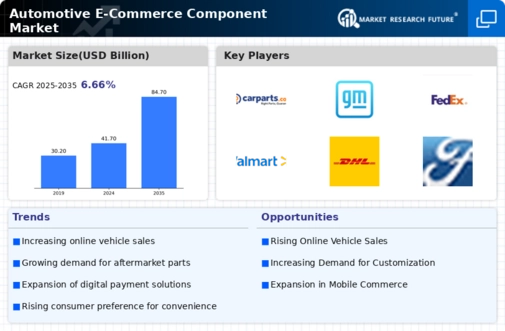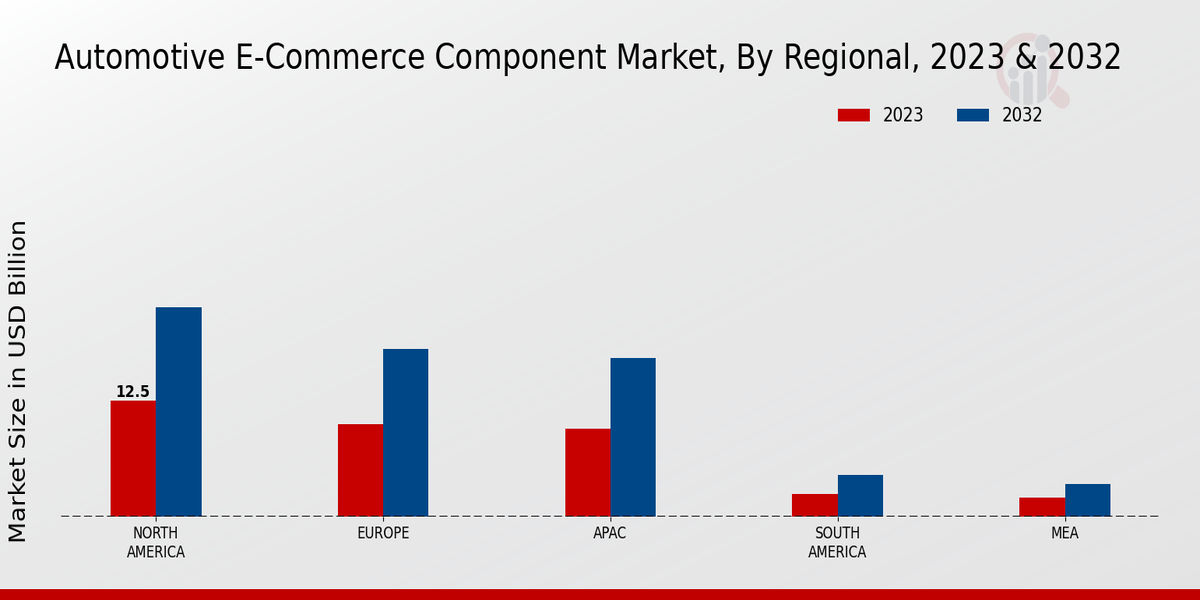Market Growth Chart
Rising Online Vehicle Sales
The Global Automotive E-Commerce Component Market Industry experiences a notable increase in online vehicle sales, driven by consumer preferences for convenience and accessibility. In 2024, the market is projected to reach 41.7 USD Billion, reflecting a shift towards digital platforms for purchasing vehicles. This trend is further supported by advancements in technology, enabling consumers to explore a wide range of options from the comfort of their homes. As more dealerships adopt e-commerce solutions, the industry is likely to witness a significant transformation, enhancing customer experiences and expanding market reach.
Increased Consumer Awareness
Consumer awareness regarding the benefits of automotive e-commerce is on the rise, positively impacting the Global Automotive E-Commerce Component Market Industry. As more individuals become informed about the advantages of online vehicle purchasing, such as price comparisons and extensive inventory access, the market is expected to expand. This heightened awareness is likely to drive more consumers to explore e-commerce platforms for their automotive needs. The projected compound annual growth rate of 6.66% from 2025 to 2035 suggests that this trend will continue to gain momentum, further solidifying the role of e-commerce in the automotive sector.
Growth of Digital Payment Solutions
The proliferation of digital payment solutions significantly influences the Global Automotive E-Commerce Component Market Industry. As consumers increasingly favor cashless transactions, the demand for secure and efficient payment methods rises. This trend is evident in the automotive sector, where platforms are integrating various payment options, including mobile wallets and cryptocurrencies. The convenience of these solutions not only streamlines the purchasing process but also enhances consumer trust. With the market projected to grow to 84.7 USD Billion by 2035, the adoption of digital payment systems is likely to play a crucial role in shaping the future of automotive e-commerce.
Expansion of Global E-Commerce Platforms
The expansion of global e-commerce platforms significantly influences the Global Automotive E-Commerce Component Market Industry. Major players are increasingly investing in online marketplaces that cater to diverse consumer needs, thereby broadening their reach. This trend is evident as platforms enhance their offerings, including vehicle financing options and after-sales services. The growing availability of these platforms is likely to attract a wider audience, including those in emerging markets. As the industry adapts to this expansion, the projected growth to 84.7 USD Billion by 2035 indicates a robust future for automotive e-commerce.
Technological Advancements in E-Commerce
Technological advancements play a pivotal role in shaping the Global Automotive E-Commerce Component Market Industry. Innovations such as artificial intelligence, augmented reality, and machine learning enhance the online shopping experience, allowing consumers to visualize vehicles in a virtual environment. These technologies not only improve customer engagement but also facilitate personalized recommendations based on user preferences. As the market evolves, the integration of such technologies is likely to attract more consumers to e-commerce platforms, contributing to the anticipated growth of the industry. The ongoing development of these technologies may redefine how consumers interact with automotive brands online.






















